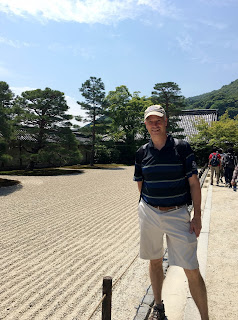 |
| Pretty frame of the zen gardens. Cute guy, too! |
By lunchtime, we're finished with the itinerary I created for the day, so now what do we do? We're (kind of) near Saihoji, known as Kokedera (Moss Temple). It's supposed to be one of the most beautiful temples in Kyoto, so we flag down a taxi for the fifteen minute drive. Ten minutes after we're in the car, the driver says "Reservation?" "Oh no," I think. I know reservations are required for the Imperial sites, but the guide book (Lonely Planet) did NOT say it was necessary for this temple. I do a quick google check, discover the taxi driver is correct, and Steve and I have a quick conversation to determine where to go next.
We decide to forget about trying to stay in west Kyoto and head across town to see one of the most popular temples, Ginkaku-ji (Silver Temple). No reservations required!
Reading about the temple makes the United States feel very young. "In 1482, shogun Ashikaga Yoshimasa built his retirement villa on the grounds of today's temple, modeling it after Kinkakuji (Golden Pavilion). The villa was converted into a Zen temple after Yoshimasa's death in 1490." (from japan-guilde.com) Columbus hadn't even made it to the continent, yet. The pavilion has survived intact since then (through earthquakes and fires), though renovation has continued on it. You would think from the name it would be covered with silver, but it's thought the nickname came about 400 years ago to differentiate it from the Golden Pavilion.
 |
| This "cone" in the zen garden represents Mt. Fuji. |
 |
| This would be pretty in our backyard... |

 |
| As you look down the hill you can see the crowds. |
But no worries - we stopped for refreshments! I couldn't resist the grapefruits. We got to pick the one we wanted, then they drilled a hole and put in a straw. And maybe we also opted for the shot of rum thrown in....
 |
| Do our smiles match the grapefruit's? |
It's a ten minute walk to Honen-in Temple, so we decide to check it out. This one's a little younger; it was built in 1680. It's my favorite zen garden so far. I like the spirals, probably because I used them in a quilting design last year. :) We sit on the steps and contemplate it for awhile, enjoying the quiet (we see only 10 other people the entire time we're here) and recovering from the crowds (or is it the rum?).

This temple supports local artists by giving them a small gallery to sell their work. Today's artist has canvases on the wall, and he tells us to take pictures, using a flash and without. The differences are interesting, but I can't figure out how I'd do this if they were hanging in my house. Would a strobe light work?
 |
| without flash |
 |
| with flash |
 It's only 2:30 pm, so we decide to push on to the big one - Kinkaku-ji Temple, aka the Golden Pavilion (we take another taxi, because it's about 5 miles away). This is probably the best known temple in Kyoto, if not in Japan. And yes, it is coated in real gold leaf. I found out it's lacquered on, so it doesn't need a lot of maintenance, just every 40 years or so! The temple has been rebuilt several times in it's (over) 600 year history; with the most recent one occurring after a fire in 1950.
It's only 2:30 pm, so we decide to push on to the big one - Kinkaku-ji Temple, aka the Golden Pavilion (we take another taxi, because it's about 5 miles away). This is probably the best known temple in Kyoto, if not in Japan. And yes, it is coated in real gold leaf. I found out it's lacquered on, so it doesn't need a lot of maintenance, just every 40 years or so! The temple has been rebuilt several times in it's (over) 600 year history; with the most recent one occurring after a fire in 1950. |
| Temple selfie - I think it's a requirement when you go! |
The place is packed - you're literally touching multiple people the entire time you're standing at the viewing platform. You're still able to get some nice photographs and the sunny day allows us to capture the reflection of the temple in the pond.
 |
| They let you get really close! |
We walk through the garden, which is on the small side. It's less crowded, though! I think the buses leave after everyone takes their photos. I love all the green, but I can see why Kyoto becomes so popular in the autumn when the leaves change colors.

There are many details to take in, but I find the dragons at the top of the gate adorable. I wish I could take them home!
 |
| Is there a gift shopping selling these? |

 |
| Do you receive more luck if your coin lands closer to the statues? |
Side note - I noticed the temple names tend to end with -ji, so I looked it up. It's an honorific, showing respect for inanimate objects. So now you know.
 |
| Can you buy these in the store? |









































